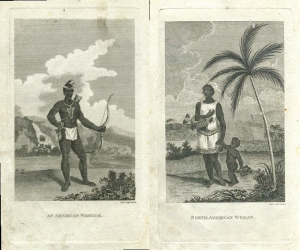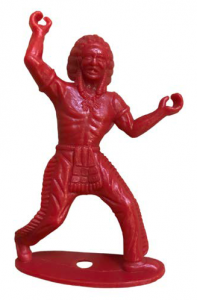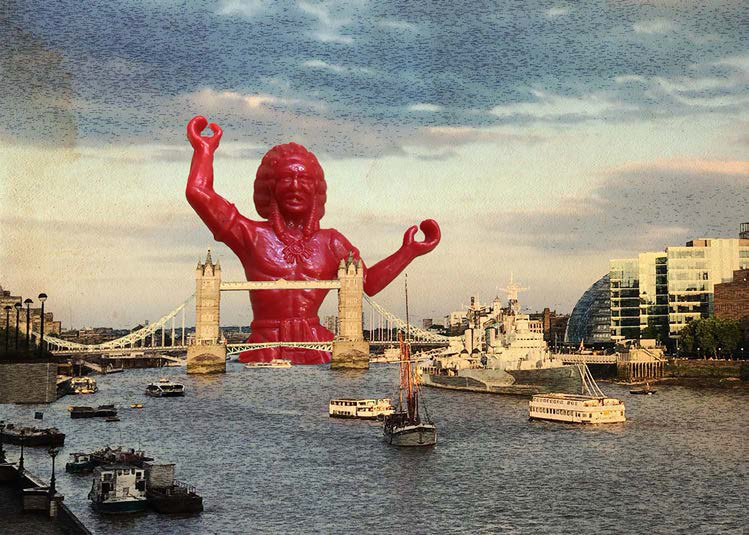Bobby C. Martin
Artist – 7 Springs Studio
As a Native artist and Muscogee Creek citizen living in Oklahoma (formerly Indian Territory), I am excited to have a small but highly visible part in ‘Beyond the Spectacle’. The collaborative spirit of this project is something I’m very keen on, and I look forward to continued reading of the discoveries made by the Spectacle researchers. As a contemporary example of what David Stirrup describes as “Indigenous mobility from their homelands to the colonial centre,” I have had the good fortune to have visited Britain several times, often in the service of opportunities to dispel the myths and stereotypes surrounding Native North Americans that still exist today. In a very real sense, my personal story is reflected in the DNA of ‘Beyond the Spectacle’, and I feel honoured to be asked to provide the signature artwork for this groundbreaking project.

In the summer of 2017, good friend and co-curator of the ‘Return from Exile: Contemporary Southeastern Indian Art’ exhibition, Tony Tiger, and I were invited to present at the American Indian Workshop in London. Quite by chance, we wandered into the ‘Pure and Applied’ frame and print shop on Bermondsey Street. There the gracious owners, David and Harriett, gifted us with some small antique bookplate engravings of ‘North American Indians.’ When I got back home I decided to do a bit of research. I found that these engraved images originated with Jonathan Carver’s journal sketches that appeared in Travels through the Interior Parts of North America, in the Years 1766, 1767, and 1768. The book “became a bestseller in London in the 1780s, and arguments over its author’s accuracy and honesty have raged ever since.” The engravings that we received copied Carver’s figures almost exactly, but in an entirely different setting. The earlier journal drawings were based on people located in the upper Mississippi River region, but ours seemed to be living in a much more tropical climate. As I did more Google searching, I found that these figures had been used multiple times, but almost every time in a completely new environment or landscape. From earliest contact, there existed the idea all Indians were alike, no matter where we were located—a time-tested strategy to dehumanise whole people groups.
This got me to reflecting on the nature of using placeholder symbols for actual people, a practice that continues unabated to the present day. In America, sports team mascots, food companies and truck stop gift shops all trade on the use of stereotypes and cartoonish symbols of ‘Indians.’ Misconceptions and generalisations of North American Native peoples remain part of the culture, effectively obscuring the actual communities who, by the way, are still alive and well. It was clear that I had to create some kind of artwork responding to these little engravings of ‘North American Indians.’

That’s when I decided to get my studio mascot, Clyde, involved. An enduring stereotype himself, Clyde was a willing representative to send to battle against the forces of misinformation and stereotyping. Though he seems a mere plastic toy, in my world his stature has grown to Godzilla-sized proportions as he looms over the horizon to face down the ‘fake news’ of colonialisation narratives. As a printmaker myself, I felt it crucial to maintain the line-by-line, hand engraved accuracy of the original prints to do justice to the concept. I enlarged the engravings to five times their original size, and began the gruelling work of hand-engraving the plates. It came to feel like a reclamation of sovereignty as I worked line by line to reproduce the originals. An unexpected bonus was finding an exact computer match of the typeface used in the original prints, which I used to engrave Clyde’s byline
into the plate. The finishing touch was overprinting the engraved plates on a traditional etching press over the top of a colour digital print of Clyde in all his oversized glory. The process of painstaking, hand-rendered
printmaking combined with computer-generated digital imagery somehow seemed an appropriate metaphor for the continued battle across time against the dehumanising aspects of stereotypes.

Now thanks to ‘Beyond the Spectacle’, Clyde has been released into the modern wild. His first appearance in the UK is wading up the Thames to lay claim to the empire. I feel sure he will be showing up in other parts of
Britain as well as other Old World locations in the near future. I am indebted to David Stirrup and Jackie Fear-Segal for the honour of allowing Clyde to serve as the ‘mascot’ (in a hopefully constructive way) for this project.
The image, A View of the River Thames, London, England with Clyde the Big Red Indian, at the top of this article is a preview of the final version. The finished print, along with the inaugural prints from the original engravings, are available from my 7 Springs Studio in the former Indian Territory of Oklahoma. I hope you enjoy following Clyde’s journeys, his adventures are just beginning…
Bobby C. Martin
7 Springs Studio
West Siloam Springs, Oklahoma, USA
www.bobbycmartin.com


Wow. I love this! Thanks for the preview.
Hello Dean! Yes, my paternal grandfather (“Papa”) was Raymond Clyde, and I inherited Clyde as my middle name. I have to admit I was semi-ashamed of the name for a large part of my life, but I finally came to accept and then be proud of such an “uncool” name. When it came time to christen my alter-ego red Indian, Clyde was the natural fit.
Bobby thanks for the information on “Clyde the Big Red Indian”. I had seen the hand engraved printing of “Clyde the Big Red Indian” but was glad to learn more. Did the name Clyde come from a family name, your grandfather Clyde Martin and your middle name Clyde?.